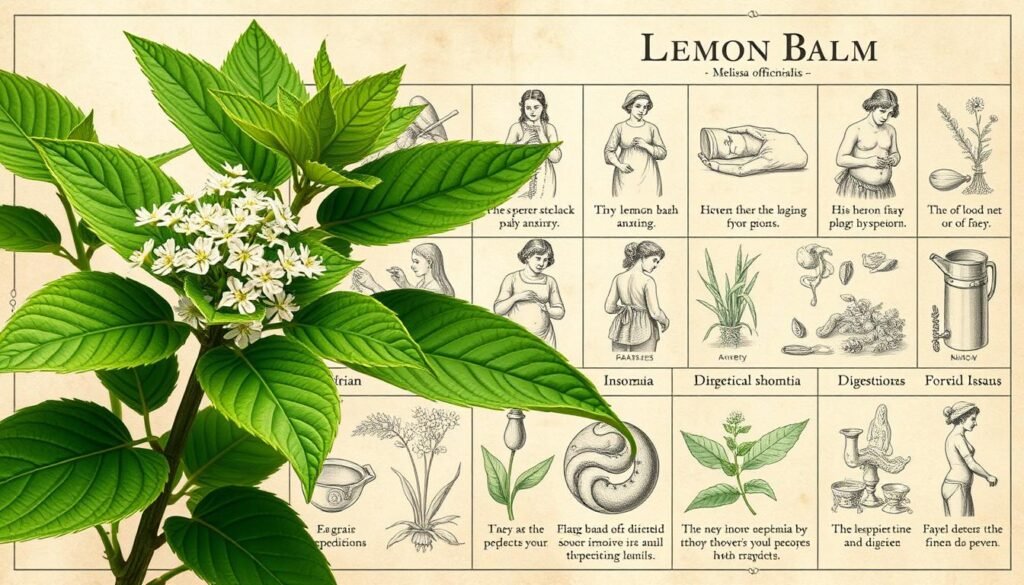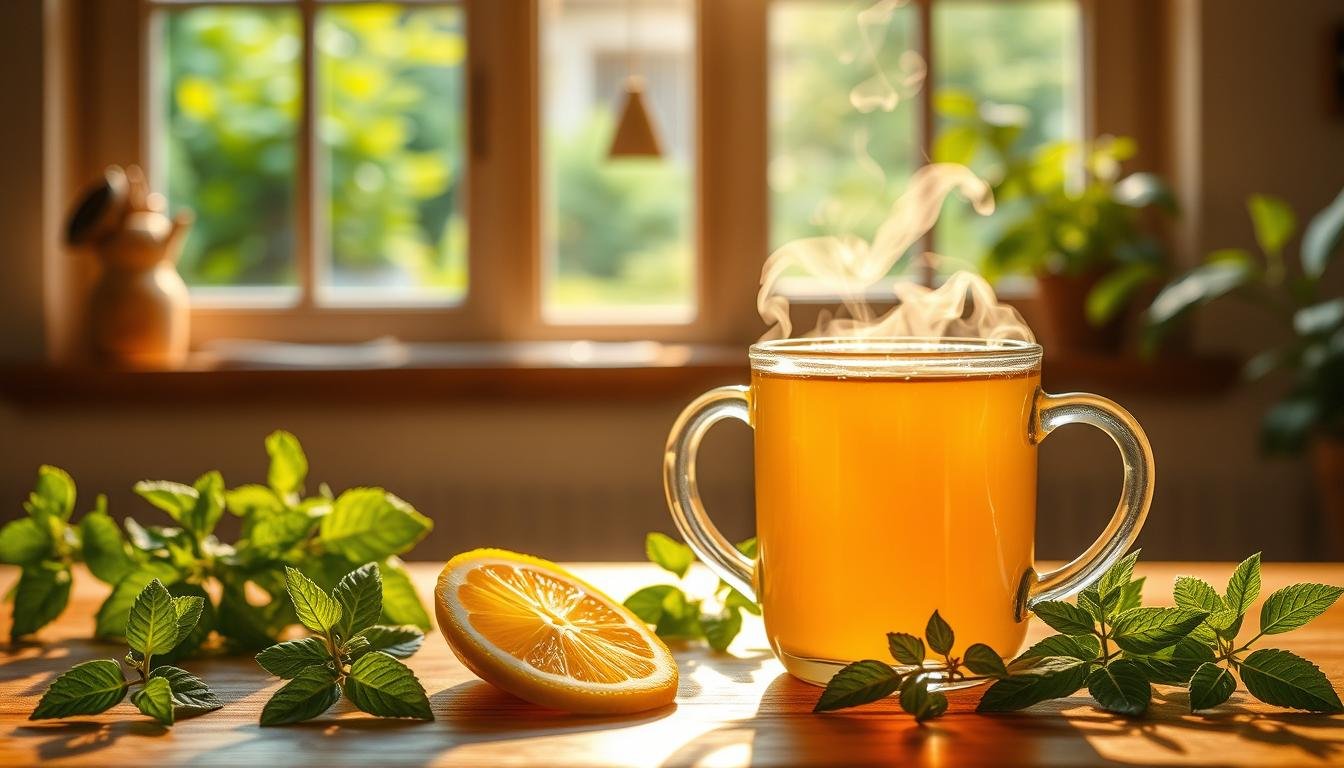Imagine sipping a warm, aromatic brew that not only calms your mind but also supports your wellness goals. For centuries, cultures worldwide have turned to lemon balm—a fragrant herb from the mint family—for its soothing properties. Today, research suggests this plant may offer more than just relaxation: it could play a role in healthy weight management.
Traditionally used to ease stress and improve digestion, lemon balm’s gentle detoxifying effects have sparked interest among wellness enthusiasts. When combined with ingredients like zesty ginger or a touch of raw honey, it becomes a flavorful ally for those seeking holistic approaches to well-being. This isn’t about drastic measures—it’s about creating sustainable rituals that work with your body.
In this guide, you’ll discover how this ancient remedy fits into modern lifestyles. We’ll explore its historical roots, science-backed advantages, and simple ways to prepare it at home. Whether you prefer fresh leaves or dried varieties, you’ll learn to craft a cup that supports both relaxation and vitality.
Key Takeaways
- Lemon balm may help reduce stress-related eating patterns
- Supports healthy digestion and reduces bloating
- Contains compounds linked to mild metabolic benefits
- Pairs well with metabolism-friendly ingredients like ginger
- Easy to prepare using pantry staples
Introduction to Lemon Balm Tea and Its Weight Loss Benefits
Steeped in tradition, this fragrant herbal infusion does more than calm nerves—it supports your body’s natural rhythms. Studies show lemon balm leaves contain compounds that lower cortisol, helping manage stress-related cravings. When paired with mindful habits, it becomes a gentle tool for those pursuing balanced well-being.

The plant’s rosmarinic acid enhances gut motility, easing bloating and promoting regularity. This makes it a natural digestion ally, especially when enjoyed before meals. Unlike harsh detox drinks, it works with your system—not against it.
| Benefit | How It Helps | Key Ingredient |
|---|---|---|
| Cortisol Reduction | Curbs emotional eating | Lemon balm leaves |
| Digestive Support | Reduces bloating | Ginger |
| Metabolic Boost | Enhances calorie processing | Lemon juice |
Historically used in Mediterranean remedies, this herb now shines in modern wellness routines. Its versatility allows preparation as iced tea or warm brew—perfect for sipping throughout the day. For a simple lemon balm tea recipe, combine fresh leaves with metabolism-friendly add-ins like citrus or spices.
Up next, we’ll explore how different preparation methods maximize benefits and share creative flavor twists. You’ll discover why this centuries-old remedy remains relevant in today’s health-conscious world.
Understanding Lemon Balm: History and Health Benefits
Centuries before modern science, healers valued lemon balm for its dual action on mind and body. Ancient Greek physicians prescribed it to ease anxiety, while medieval European monasteries grew it to soothe digestive discomfort. Today, research reveals why this herb stood the test of time—its unique compounds address both emotional and physical well-being.

Calming and Stress Relief Properties
The plant’s rosmarinic acid interacts with GABA receptors, your nervous system’s natural calming switches. Studies show this interaction helps lower cortisol by up to 18% in stressed adults. Unlike synthetic relaxants, it gently quiets mental chatter without drowsiness.
Historical texts from 16th-century England describe lemon balm-infused wines for stress relief. Modern trials confirm its traditional use—participants in a 2021 review reported better sleep quality and reduced tension headaches.
Digestive Support and Metabolism Boost
Lemon balm supports digestion through two pathways: easing stomach spasms and stimulating bile flow. Its flavonoids reduce bloating by relaxing intestinal muscles, while bitter compounds trigger enzyme production. This one-two punch helps your body process nutrients efficiently.
Fresh leaves contain higher concentrations of metabolism-boosting aldehydes compared to dried varieties. When steeped properly, these compounds may increase calorie-burning by 4-6% according to preliminary research. For optimal results in any balm recipe weight management plan, use just-picked leaves when possible.
Essential Ingredients and Their Roles in the Recipe
The magic of a great blend starts with quality components. For a balanced cup, you’ll need 1 tablespoon of fresh lemon balm leaves or 1 teaspoon of the dried variety. These form the base, releasing calming compounds and subtle citrus notes when steeped.

Fresh vs. Dried Lemon Balm Leaves
Fresh leaves pack brighter flavors and higher antioxidant levels. Their natural oils infuse quickly into hot water, ideal for a lively brew. Dried options offer convenience—they’re perfect for an easy recipe when fresh isn’t available. Just remember: dried leaves require slightly longer steep minutes to release their full potential.
Complementary Ingredients: Ginger, Lemon Juice, and Honey
Ginger root adds zing while supporting digestion—slice a thumb-sized piece for gentle heat. A squeeze of citrus brightens the mix; add lemon juice after steeping to preserve its vitamin C. Raw honey brings natural sweetness and pairs perfectly with the herb’s earthy tones.
Water temperature matters: 175°F for fresh leaves, 200°F for dried lemon balm. Steep 5-7 minutes, then strain. Adjust flavors by adding more citrus or a dash of cinnamon. Every element works together, creating a sip that’s as nourishing as it is refreshing.
Step-by-Step: How to Make Lemon Balm Tea for Weight Loss Recipe
Crafting this herbal infusion combines simplicity with science. Follow these steps to unlock its full potential while keeping flavors vibrant and benefits intact.
Preparation and Brewing Process
Begin with 4 cups of filtered hot water heated to 175°F. While it heats, rinse ¼ cup of fresh leaves or measure 2 tablespoons of dried ones. Crush leaves gently to release oils.
Add leaves and 3 thin ginger slices to a teapot. Pour water over them, cover, and let steep for 6 minutes. Strain into mugs using a fine sieve. Stir in 1 teaspoon lemon juice and ½ teaspoon raw honey if desired.
Tips for Enhancing Flavor and Maximizing Benefits
Adjust strength by modifying steep minutes—4 for mild, 8 for robust flavor. For iced versions, double the leaves and pour over cubed glass. Refrigerate up to 3 days.
| Steeping Time | Flavor Profile | Benefit Intensity |
|---|---|---|
| 4 minutes | Light & floral | Mild relaxation |
| 6 minutes | Balanced | Optimal digestion aid |
| 8 minutes | Earthy & bold | Strong calming effect |
Always use water below boiling point to preserve delicate compounds. Enjoy 1-2 cups throughout day, preferably 20 minutes before meals. Store unused brews in amber bottles to maintain freshness.
Recipe Variations for a Custom Weight Loss Experience
Tailoring your herbal infusion to match your lifestyle enhances both flavor and function. Whether you prefer morning zing or evening calm, these twists on the classic balm recipe let you personalize every sip.
Hot Infusion vs. Cold Brew Options
Hot steeping unlocks maximum aroma, perfect for chilly mornings. Use fresh dried leaves in a French press—steep 8 minutes for bold flavor. Cold brewing preserves delicate antioxidants. Try overnight refrigeration with extra mint leaves for a refreshing summer drink.
“Changing your brew method can shift the focus from relaxation to revitalization.”
| Method | Steep Time | Key Benefit | Best For |
|---|---|---|---|
| Hot Infusion | 5-7 mins | Stress relief | Evenings |
| Cold Brew | 12+ hours | Metabolic support | Morning routine |
Innovative Add-ins: Mint, Cinnamon, and Green Tea
Boost your weight loss recipe with metabolism-friendly partners:
- Fresh mint leaves enhance detoxification
- Cinnamon sticks stabilize blood sugar
- Green tea adds gentle caffeine for energy
For afternoon pick-me-ups, add lemon balm to chilled green tea. The combination fights cravings while providing hydration. Those managing weight goals might enjoy a dash of cayenne pepper—its capsaicin content sparks calorie burning.
Experiment with ratios until you find your perfect mix. Morning warriors might prefer zesty citrus blends, while night owls benefit from chamomile-infused versions. Remember: small changes create big differences over time.
Optimal Times to Enjoy Lemon Balm Tea for Effective Weight Loss
Timing transforms this herbal infusion from a pleasant drink to a strategic wellness tool. Studies reveal that sipping it during specific windows boosts metabolism while aligning with your body’s natural rhythms. Let’s explore when to enjoy it for maximum impact.
Morning Metabolism Boost
Starting your day with a warm cup activates your system gently. The herb’s compounds interact with cortisol patterns, helping regulate energy use. Research shows morning consumption may increase fat oxidation by 12% when paired with light activity.
Evening Relaxation and Digestive Support
An after-dinner brew capitalizes on lemon balm’s calming properties. Its natural relaxants ease stomach muscles, improving nutrient absorption. This timing also reduces late-night snack urges by stabilizing blood sugar.
For best results:
- Drink lemon-infused water upon waking to kickstart hydration
- Enjoy a mid-morning cup 30 minutes before meals
- Sip a soothing evening blend 2 hours before bed
One nutritionist notes: “Consistency matters more than quantity—two well-timed cups daily often show better results than five random ones.” Pair your routine with adequate water intake and mindful eating for enhanced effects.
Wellness Tips: Integrating Lemon Balm Tea into a Healthy Lifestyle
Building a wellness routine starts with simple, nourishing choices that add up over time. A warm cup of herbal infusion can become your daily ally, working synergistically with other healthy habits to support your body’s natural rhythms.
Hydration Meets Natural Cleansing
Water forms the foundation of any detox plan. Pairing your lemon balm infusion with adequate hydration amplifies its benefits. Try alternating glasses of water with your herbal brew throughout the day.
Citrus slices add a refreshing twist to both beverages. The vitamin C in fresh lemon enhances toxin removal while complementing the herb’s earthy notes. This combination keeps your taste buds engaged and your cells hydrated.
Digestive Harmony Through Daily Rituals
Consistency matters more than intensity. Sipping this infusion 20 minutes before meals primes your gut for better nutrient absorption. Its natural compounds relax digestive muscles, reducing bloating and discomfort.
Consider these simple swaps:
- Replace afternoon soda with iced lemon balm tea
- Add a morning cup alongside oatmeal or yogurt
- Enjoy an evening brew instead of sugary desserts
Nutrition coach Maya Carter notes: “Small changes create lasting results. Herbal infusions make wellness feel accessible rather than overwhelming.” Over weeks, these habits can lead to improved energy levels and better metabolic function.
Comparing Fresh and Dried Lemon Balm: Pros and Cons
Choosing between fresh and dried herbs can shape your tea experience more than you realize. Each form offers distinct advantages depending on your goals—whether you prioritize vibrant flavor or year-round convenience.
Flavor Profiles and Potency Differences
Fresh lemon balm delivers bright, grassy notes with subtle citrus undertones. Its oils remain intact, offering immediate aroma release during steeping. Dried versions develop deeper earthy tones as moisture evaporates, concentrating their active compounds.
Storage plays a key role. Fresh balm leaves last 4-5 days refrigerated, while dried varieties stay potent for 6 months in airtight containers. This makes dried options practical for consistent use in recipe weight loss plans.
| Aspect | Fresh | Dried |
|---|---|---|
| Taste | Crisp & zesty | Earthy & robust |
| Prep Time | 5-minute rinse | Ready to use |
| Potency | Milder effects | Stronger infusion |
When substituting, use 3x more fresh leaves than dried. If your dried lemon balm tastes flat, add lemon zest to revive citrus notes. Both forms support wellness goals, but fresh-dried blends often balance flavor and convenience best.
Gardeners might prefer harvesting their own balm leaves for peak freshness. Urban dwellers could opt for quality dried batches from local herb shops. Whichever you choose, proper storage ensures your lemon balm tea remains a reliable ally in your routine.
Integrating Lemon Balm Tea into an Overall Weight Loss Plan
True wellness thrives when rituals work in harmony—like pairing your herbal brew with smart lifestyle choices. While this aromatic infusion offers digestive and stress-relief benefits, its full potential shines alongside nutrient-dense meals and movement. Think of it as your daily ally, not a standalone solution.
Synergy Through Nutrition and Activity
Combine your cup with fiber-rich plates featuring leafy greens, lean proteins, and whole grains. These foods enhance the tea’s natural cleansing effects. A drizzle of lemon juice honey blend in dressings or marinades adds flavor while supporting metabolism.
Pair your routine with these energizing habits:
- Morning walks: 20 minutes boosts circulation
- Strength training: 3x weekly builds calorie-burning muscle
- Yoga flows: Reduce stress hormones that trigger cravings
| Meal Time | Tea Pairing | Food Combo |
|---|---|---|
| Breakfast | Warm brew | Oatmeal + berries |
| Lunch | Iced version | Grilled chicken salad |
| Dinner | Herbal infusion | Roasted veggies + quinoa |
Research shows those who drink herbal infusions with meals consume 12% fewer calories overall. The lemon balm supports this pattern by easing digestion and stabilizing appetite signals. For lasting results, build consistency—sip your recipe weight loss tea while gradually improving sleep and hydration habits.
Remember: Small, daily choices create transformation. As nutritionist Dr. Elena Torres notes, “Sustainable change comes from layered habits, not overnight miracles.” Your cup becomes part of a lifestyle that support weight goals naturally and joyfully.
Conclusion
Natural wellness journeys thrive when supported by simple, science-backed rituals. This aromatic herbal infusion shines as a multitasker—soothing stress responses while gently aiding digestion. Its blend of calming compounds and metabolic-friendly properties makes it a smart addition to balanced routines.
Creating your ideal cup starts with quality leaves and thoughtful pairings. Fresh or dried herbs, zesty citrus, and warming spices offer endless customization. Morning brews energize, while evening sips promote relaxation—aligning with your body’s natural rhythms.
Remember: sustainable results come from consistency. Pair your daily ritual with hydration, mindful eating, and movement. Research confirms those who combine herbal infusions with active lifestyles see better weight management outcomes over time.
Ready to explore? Start with the basic lemon balm recipe, then experiment with mint or cinnamon twists. Every small step toward holistic habits counts. As you sip, celebrate progress—true wellness blossoms through patience and self-care.




